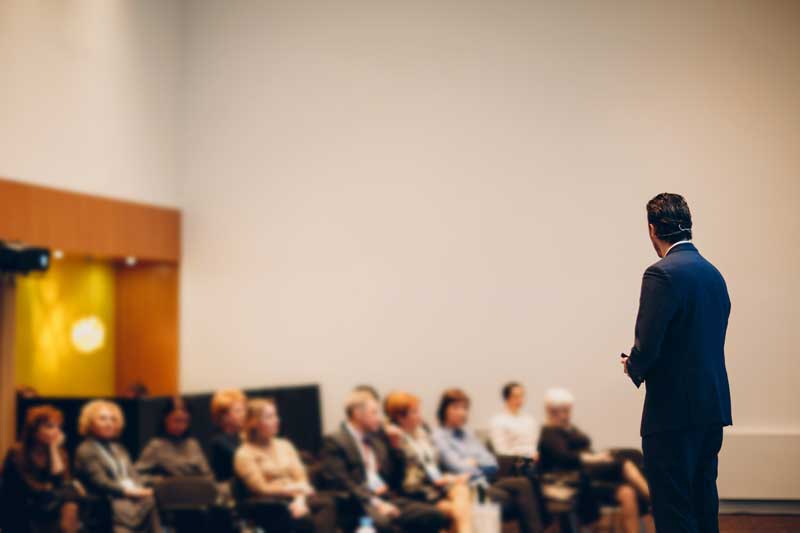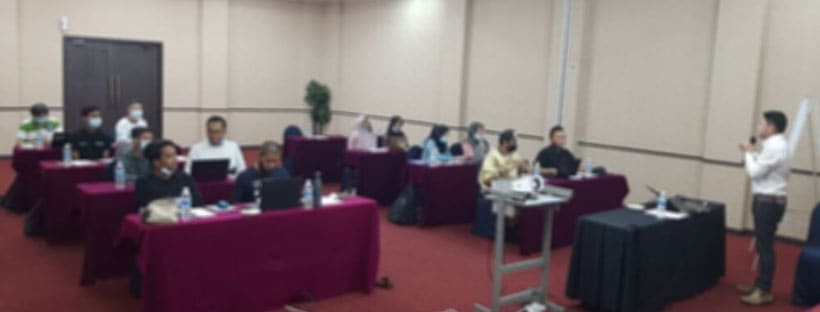In this seminars marketing guide, I’ll share you tips as you plan and execute your own in-person seminars. Let’s begin by talking a bit about what events marketing is and why it’s beneficial for your business.
Then, let’s look at two common types of events: traditional seminars and networking seminars.
Next, I’ll share you through important activities to do before, during, and after a seminar to ensure success.
Finally, I’ll give you a timeline to help you plan.

What Is Events Marketing and Why Is It Important for Your Business?
Events marketing covers all activities geared toward preparing, executing, and measuring the success of in-person or online events.
In a world where inexpensive digital marketing tactics (such as email campaigns, social media marketing, and online advertising) abound, you might ask why you’d go through the trouble of putting together an in-person event.
The answer is that in-person events are effective. They give you the opportunity to develop relationships in a way that digital marketing tactics simply can’t. And, ultimately, these events help you expand your business.
According to the Event Track 2016 Content Edition report, 74 percent of consumers said that engaging with branded event marketing experiences made them more likely to buy the promoted products.
In short, these events are good for business.
Through the remainder of this guide, let’s focus on a particular category of in person events, seminars and how to do them.
Two Types of Seminars: Traditional and Networking
Let’s look at two common types of seminars, traditional seminars and networking seminars.
Traditional Seminar
Traditional seminars typically last for about two hours and are set in large rooms with multiple rows of seats facing a presenter. They usually include a 30- to 45-minute presentation or demo of a product or service that is bookended by time to eat snacks, drink beverages, and socialize.
Networking Seminar
The purpose of networking seminars is to gather customers, prospects, and even partners together to socialize, talk through common challenges, and set up future conversations. Networking seminars tend to work best in large, open rooms with a few tables for food, seating, and demos. These seminars typically begin with a 10- to 15-minute informal welcome given by one of the hosts. This is followed by about 90 minutes of socializing. There may also be product demo stations set up so attendees have a chance to see, test, and talk about solutions.
Executing a Successful Seminar
Thoughtful planning for steps to take before, during, and after your seminar are critical for ensuring success. In this section, we’ll guide you through a set of activities you can follow as you begin executing your own seminars.
Before the Event
12-10 weeks out
- Identify your purpose and topic. As you start to plan, begin by identifying the purpose and topic of your event. Are you aiming to give prospects a comprehensive understanding of your company? Or do you want to focus on a particular aspect of your product or solution? Once you settle on the purpose and topic, craft a brief, one paragraph description of your event that can be used both internally and in external marketing materials.
- Set goals. Setting goals for things like number of registrants, attendees, and booked appointments will give you a baseline for measuring your success and having post-mortem conversations after the seminar on what you can do to improve for future events.
- Choose a date and time. Settle on the date and time for your event. We suggest that you start planning events about 12 weeks out so you have sufficient time to prepare. There isn’t any rule of thumb for the best time of day to host a seminar. Some people prefer mornings, others recommend lunchtime, and still others say that the end of the workday is the best time. We recommend experimenting. As you put on more seminars, try out different times of day, and figure out what works best for you.
- Establish a call to action. Typical calls to action (CTAs) for a seminar include encouraging attendees to sign up for a consultation or book an appointment. During networking seminars, you may also have a booth set up for giving in-person demos. In this case, one of your calls to action would involve encouraging seminar attendees to sign up for an in-person demo.
- Book a venue. Book your venue early. The type of venue you’re looking for depends on your seminar type. If you’re hosting a traditional seminar, you’ll want a conference room with presentation tools and rows of chairs. For a networking seminar, you’ll probably want an open floor with areas to set up demo stations and food and beverage tables.
- Decide on promotional and marketing materials. You may need to create two types of materials for your event: promotional and marketing. Promotional materials are designed to promote your event. This includes invitation emails and reminder emails with an add-to-calendar CTA, web banners, an event landing page and registration pages, social media posts, blog posts, and follow-up emails. (See the Resources section for helpful guides for these pieces.) Marketing materials include items you’ll provide attendees during your event, such as pamphlets, brochures, and one-pagers. (It’s a good idea to check with your marketing department as they may already have materials they can let you use for your event.) After you’ve decided on the types of marketing you’ll be providing, delegate people within your organization to take charge of developing these materials.
10-8 weeks out
- Put together a contact list. At this stage, you’ll want to put together a contact list for your invitees. This list may include prospects or customers or partners, or some combination thereof. It’s a good idea to collaborate with your sales team to help put this list together.
- Find and confirm a speaker. If you’re hosting a traditional seminar, you’ll need a speaker for the presentation portion. Your choice of speaker will depend on your seminar’s subject. If your seminar is focused on your product, ask someone from your product team to do the presentation. If your seminar is focused on customer success, invite a person from marketing to put together a presentation.
- Decide on food and beverages. It’s best to keep your menu simple. One thing to keep in mind is the time of day of your event. If it’s scheduled for early in the morning, pastries, coffee, and juices are probably a better offering than sandwiches and salad. Then again, sandwiches and salad could be perfect for an event hosted in the afternoon or early evening.
11-3 weeks out
- Drive attendance. At this point, you’ll want to send out invitation emails. In addition, promote your event through other channels, such as announcing it on your social media platforms, publishing a blog post promoting the event, and asking members of your prospect and customer-facing teams to include details and a link to your event’s registration page in their email signatures.
- Print any necessary marketing materials. If you decided to include marketing materials for handing out to event attendees, such as one pagers, brochures, or pamphlets, this is the time to get them printed and ready for use at the seminar.
- Put together your presentation and demo. During this stage, you’ll want to begin writing and creating any slideshows you plan to include in your presentations and demos. One thing to keep in mind as you develop your content is that the information you present should be primarily educational. Attendees are coming to your seminar to learn, so you’ll want to avoid language that feels too sales heavy. Be sure to budget time for internal reviewers to proofread, revise, and finalize your work.
- Delegate tasks. Think about the kind of staffing you’ll need for your seminar, and delegate tasks to different member of your team. Typical tasks for a seminar include greeting and signing in attendees, handing out marketing materials, setting up and breaking down equipment, and manning tables or booths.
3 weeks-1 week out
- Practice presentations and demos. Running through the seminar presentation and demos a few times prior to the event will help you iron out kinks and give your speaker the practice needed to ensure success. Scheduling two or three mock presentations or demos prior to the event is ideal.
- Send reminders and follow-ups. In the final weeks leading up to the event, you’ll want to send reminders (usually by email) to people who signed up for your event, and follow-ups to people who haven’t registered yet. Typically, you’ll send a first reminder and follow-up one or two weeks prior to your event, and then a final reminder one or two days before your event. In these reminders and follow-ups, be sure to include all the important details about the event, such as the date, time, location, benefits of attending, and speaker details.
During the Event
- Arrive early. Arrive at your seminar venue at least one hour prior to the event’s start time to make sure everything is set up when attendees arrive. As you near the start time of the event, make sure your staff is stationed to greet and sign in guests and hand out any marketing materials.
- Drive toward your call to action. During your event, be sure that you are driving toward your CTA. If your CTA is for attendees to sign up for a consultation or one-on-one appointment, set up a table specifically for this purpose and assign a person to staff the table and help book appointments. Before, during, and at the end of your presentation, remind people about the CTA and make sure they know where and how to sign up.
After the Event
- Follow up with non-attendees. The day after the event, send a follow-up email to all those on your contact list who were unable to attend. Include highlights about the event and details for any similar upcoming events. You should also include your event’s CTA. This can be something along the following lines: “Even if you weren’t able to make it to our event yesterday, you can still book an appointment. Send an email to [email protected] with the subject line ‘I’d Like to Book an Appointment.’”
- Follow up with attendees. Two or three days after your event, send out a follow-up to your attendees. Thank them for coming to your event and, as with the follow-up to non-attendees, remind them about your CTA and provide them with instructions for how to schedule an appointment or consultation.
- Analyze your metrics and improve. Identify where you were successful in hitting your goals and where you missed the mark. Consider where you can make changes or adjustments to your tactics and find ways to implement this information as you plan for future seminars.
METRICS COLLECTION:
- Number of registrants
- Number of attendees
- Attendee ratio: Number of attendees divided by registrants (target 50%+)
- Number of appointments set or qualified leads
- Appointment/qualified lead ratio: Number of appointments/leads divided by attendees (target 20%+)

Planning The Timeline For Events
Here is a sample timeline for the execution of a seminar, from development to follow-up. You’ll need to make modifications to suit your particular needs this is simply to get you started.


